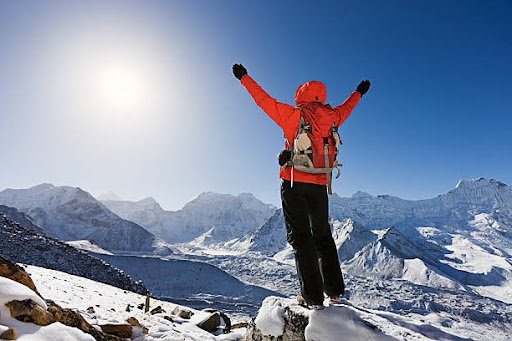Exploring the Dark Realities of Rainbow Valley: A Journey

Do you intend to hike around Mount Everest? Alternatively, would you like to conquer Mount Everest? Are you interested in learning more about the shadowy sides of Rainbow Valley? This article can be your safety net if you have decided to climb the world’s tallest mountain but are unaware of the heartbreaking stories surrounding Mount Everest. To make appropriate travel plans, familiarize yourself with the schedule in-depth as well as the history of Mount Everest and the Rainbow Valley.
Everest’s Rainbow Valley Summit
The Himalayan diamond is a place of physical significance, human triumph, and natural splendor. Every year, hundreds of adventurers and tourists flock to Mount Everest, which towers over 8848 meters above sea level. Trekkers can experience the breathtaking splendor of the surrounding region while pushing their physical limitations. Visitors to Rainbow Valley can take in a singular fusion of contemporary tourism and antiquated customs. They hike across difficult terrain to the mountain’s base, see ancient monasteries, and delve deeper into Sherpa culture.
Rainbow Valley Mt Everest is not what we initially imagined it to be, despite what the name implies. With its stunning views of snow-capped peaks, glittering glaciers, and vivid valleys that seem to sparkle with every hue of the rainbow, it appears like a place that might represent something, but it also has a darker side. With the opportunity to see the magnificence of nature, it certainly welcomes tourists and adventure seekers. The phrase “Rainbow Valley,” however, alludes to the area in the Everest region where climbers failed to reach their ideal target and perished in the process.
Death Zone of Rainbow Valley MT Everest
Situated beneath the northern ridge of Mount Everest, the world’s tallest summit, the Rainbow Valley lies above an elevation of 8,000 meters in the Everest region. Due to the great altitude and oxygen deprivation, which can result in a range of physical and mental deteriorations and potentially fatal disorders, the area is known as the “zone of death.”
One could wonder why something with so many dead bodies of failed climbers would be given such a name. The area’s name is derived from the rainbow-like colors—red, green, blue, orange, and so on—that are found on the jackets that cover the bodies of the dead.
The creation of Rainbow Valley on Mount Everest—the peak’s death zone
The reality of Rainbow Valley Mt. Everest is just as terrifying as the moniker suggests. The Everest region’s Rainbow Valley also referred to as the “death zone,” results from low oxygen levels brought on by the high altitudes. It is difficult for humans to breathe at this altitude since the air pressure is only one-third of what it is at sea level.
Furthermore, the routes to the summits of Mount Everest are restricted, making it difficult for climbers to complete the pathways successfully; a small mistake on these roads could send your corpse straight to the evocatively called but horrifying Rainbow Valley.
Numerous climbers have lost their lives in this zone, transforming it into something akin to a cemetery. Every time someone loses their life attempting to fulfill their dream of reaching the peak of Everest, the number of casualties rises due to the exorbitant and dangerous cost of recovering the dead bodies.
For the most adventurous hikers and mountaineers, however, reaching Everest Base Camp and climbing Everest remain dreams. Most individuals have a burning desire to go on this once-in-a-lifetime experience, and at least 800 people attempt to reach the top of the world’s highest peak each year.
While many of them give up in the middle, the majority manage to overcome it. The saddest aspect, though, is that one in ten people buries their dreams with their bodies in the freezing climate, placing them one above the other. Every time a traveler crosses Rainbow Valley, Mount Everest, they are forced to observe the dead bodies there because of the extreme cold, which prevents the corpses from ever decomposing.
The primary reason for death in Rainbow Valley is Mount Everest
Sagarmatha, often known as Mount Everest, is a magnificent marvel that draws tourists and nature lovers from all over the world. The majority of the time, people are drawn to hike Everest because of its breathtaking beauty, which gives them the impression that they are touching the sky despite the mountain’s challenging conditions. Not only do the snow-covered landscapes deliver a feeling of incomparable, unadulterated beauty that is difficult to put into words, but the entire trip, from the vibrant prayer flags to the breathtaking glaciers and swift-moving frozen rivers, is a sensory feast.
Above 8000 meters is Rainbow Valley. Oxygen levels become too low at higher altitudes to support human life for long. Above this point, hikers face additional risks such as exposure to increased UV radiation, restricted trails, altitude sickness, freezing temperatures, and extreme weather.
But every year, a lot of hikers are drawn to Everest’s breathtaking splendor, which puts their every step on a balance between life and death. Acute mountain illness is responsible for 22.2% of fatalities on Mount Everest, whereas avalanches account for 41.6% of deaths. Other causes of fatality in the Everest ascent include falls and weariness. As of 2022, there are still more than 200 dead bodies in the Rainbow Valley of Mount Everest as a result of these regions.
What Befalls the Dead Bodies in Mount Everest’s Rainbow Valley?
The odds of a body remaining in Rainbow Valley Mount Everest forever are very high, and the number of deceased people there is continually rising. High winds make it difficult not only to retrieve the remains with the aid of helicopters, but it is also nearly impossible to deploy rescue personnel because no one can assist alone and too few people can stay on the narrow trails at once.
The bodies must therefore be pushed by the passengers down to Rainbow Valley, which is located 1000 meters below the summit of Everest. Travelers have little choice but to push those bodies down to clear roads, even though it sounds dreadful. Some of the deadfall, unable to escape the brutal weather and circumstances that cause them to pile on top of one another.
Why are corpses piling up in Mt. Everest’s Rainbow Valley?
In addition to being far higher up, Mount Everest has extremely low temperatures. Altitude sickness, which can be fatal to humans, is caused by dangerously low oxygen levels as a result of the thinner air at higher altitudes. Those who pass away in death zones fall into Rainbow Valley or on the paths that go up to the top of Everest’s breathtakingly beautiful peak.
The fact that it is difficult to retrieve the remains of people who have perished on the mountain is the reason why bodies continue to accumulate in the rainbow valley of Mount Everest. As a result, to proceed, the pedestrians on the road are forced to toss the bodies to the ground. Additionally, the idea of deploying a helicopter at such higher altitudes is completely absurd due to the awful conditions caused by hurricane winds.
Conditions of Rainbow Valley Mount Everest
Above 8000 meters is the Everest death zone, popularly referred to as Rainbow Valley because of the brightly colored body jackets and debris that give the area a rainbow-like appearance. Because of the challenging conditions in this area, it is challenging for passengers to navigate the trails without oxygen.
The human body is already having difficulty getting enough oxygen at this altitude, and the combination of strong winds and low temperatures makes it difficult for climbers to see and navigate, leading to whiteout conditions. Even seasoned climbers find it challenging to survive here due to the lethal combination of thin air, oxygen deprivation, and dehydration.
To reduce the likelihood of the worst situations occurring and to ensure one’s safety, sufficient safety measures or the advice of knowledgeable Everest trip operators should be followed.
To simplify your journey, you can also reserve a helicopter ride to reach Everest Base Camp.
Mt. Everest Survival in Rainbow Valley
There is still no definitive answer to the question of how difficult it is to climb Mount Everest because it mostly depends on a person’s level of physical fitness, mental toughness, level of preparation for the journey, and many other factors. However, if you have set your mind to climbing the world’s highest peak, you should be at least somewhat prepared. The following are some strategies for surviving an Everest trek:
The most important requirement for starting an Everest expedition is being in good physical and mental health. So train yourself so that even on direct hikes to high heights, your body won’t become fatigued.
Investing in the proper equipment is another crucial step that travelers shouldn’t take. Only if you take proper care of your body will it be able to travel with you. So, invest in sturdy, comfortable apparel rather than pricey items.
Keep yourself hydrated and carry extra oxygen to lower your chance of altitude sickness.
While visiting Rainbow Valley Mt. Everest, make sure to travel with knowledgeable tour operators. Expert guides with knowledge of the area, weather, and safety measures are a great resource in the event of an emergency.
Take caution when taking risks and focus intently on the details your body is displaying. Do not exert yourself further if you believe that your body cannot adjust to the weather. The voyage is not nearly as valuable as your life.
Popular Narratives regarding Everest’s Rainbow Valley
In addition to being a breathtakingly beautiful mountain, Everest has many unspoken, dark truths. It is home to lovely spirits that perished in horrific accidents and will never return:
Green Boots
An old climber named Green Boots is said to have died and his body is lying on Mount Everest. The green climbing boots he was wearing when he passed away are the source of the name. It is believed that the climber, whose full identity is unknown, is an Indian by the name of Tsewang Paljor. The mountaineer was climbing with two other people when the event occurred in 1996, but only one of the three dead bodies—named Green Boots—was discovered.
When a French climber uploaded his video footage in 2001, the story of Green Boots became public knowledge. When the lifeless body of another English climber, David Sharp, was discovered close by, this was later used as a landmark. The location of his death, known as “Green Boots Cave,” is a popular stopping point for climbers preparing to ascend Mount Everest.
The body of Green Boots has been attempted to be removed from Everest numerous times, but none of the attempts have succeeded. As a result, it remains in place, symbolizing both his failed victory and the dangers and worries that could make other climbers more cautious about their safety.
Though many climbers have seen the body there, it is one of the frequent horrifying legends of Everest. Now, the body is reportedly no longer there. It may have been pushed away or covered by snow.
The Sleeping Beauty of Everest
Sleeping Beauty is another well-known yet tragic Everest tale. The ending is not as wonderful as it sounds, despite the name. The narrative of Sleeping Beauty of Everest is not about a peacefully sleeping person, but rather about a female mountaineer whose corpse appears to be sleeping, earning her the moniker “Sleeping Beauty.” The first American woman to attempt an oxygen-free summit ascent of Everest was Sleeping Beauty, also known as Francys Arsentiev. In 1998, she and her spouse attempted to climb Mount Everest together, but they only stayed for two days at Camp 6.
Nevertheless, their oxygen supply ran out before they could summit the top, forcing them to spend additional days at the camp. Later on, her spouse decided to descend back to the bottom, but Francis managed to keep her composure. She decided to give her ambition of reaching the top of Everest one last go and set out on her adventure without any assistance. She was discovered 1000 meters below the Everet, having sadly failed to reach the summit. She was eventually discovered by a group of Uzbeks, who attempted to save her but were unsuccessful and left her with some oxygen supplement. She passed away there while dozing off, earning the moniker “sleeping beauty Everest.”
Concluding Remarks on Rainbow Valley Mount Everest
Life and death are ongoing processes that we are powerless to halt. For the majority of people, climbing Everest fulfills a dream they had of conquering the mountain as well as a test of their physical endurance. People attempt for this reason, regardless of what the journey may hold.
A symbol of human achievement, a testament to the force of nature, and a wonder of the natural world, Mount Everest is undoubtedly impressive. It is a genuine marvel of the world that fills everyone who sees it with amazement and delight. Take your chances if you have aspirations of becoming at the top since you never know what the future holds. It may be a victory, but be sure you’re adequately equipped for the trip.




